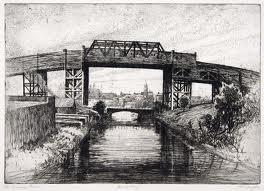Gowanus Superfund Site Could Reveal Historical Artifacts and Clean Water, Too

As the Superfund clean-up of the Gowanus Canal in Brooklyn is about to get underway, some history buffs and professional historians are hoping for buried treasure of the archeological variety to be unearthed along with the clean water.
Of what are the preservationists dreaming? Maybe the remains of a tidewater mill dam? Or perhaps some Indian arrowheads and fishing hooks? Or per chance a few bullets, brass buttons or even a couple of human bones left there from the Battle of Brooklyn?
High Expections for Archaeological Finds
Kimberly Maier is the executive director of the Old Stone House, a museum built on the site where about 400 Maryland soldiers were almost completely destroyed while they bravely held back a considerably larger force of British soldiers in August of 1776. Ms. Maier and the Old Stone House keep alive the memory of the sacrifice made by soldiers from Maryland during the Revolutionary War. She reminds us of the importance of the site for American History. “Very few people realize that the largest battle of the Revolutionary War was fought in Brooklyn. There’s always been this great mystery of where the Marylanders were buried” she said. “Were they in one specific grave about 100 feet from the curb along Third Avenue between Seventh and Eighth Streets, or dumped into the Gowanus wetlands? What turns up would be amazing.”
However, even less well known then the Battle for Brooklyn is the fact that the EPA has also been invested with the responsibility of preservationist along with its job of cleaning up toxic waste sites. The EPA must comply with the National Preservation Act, and as such documents and salvages historically significant artifacts found while cleaning contaminated ground, buildings, and sediment at the bottom of rivers and canals.
Cleaning and Preserving
But it is not necessarily a given that Superfund implementers will be on the lookout for historical treasures. After all, it is the Environmental Protection Agency that administers the fund and they are not always so keen on utilizing their resources to guarantee that the National Historic Preservation Act is followed to any greater degree than is absolutely needed. According to Fredric L. Quivik, professor of industrial history and archaeology at Michigan Technological University, the quality of the preservation is often determined by the zealous nature of the particular EPA administrator in a certain region. “Some administrators are single-minded about a cleanup. If so, then they may consider preservation efforts a distraction form their real mission in life” to clean up the site. Quivik’s conclusion is that, “If there are local constituencies who care about these cultural resources, they’ll raise a ruckus.”
Federal officials explained that there are about 1300 Superfund sites at the moment with between 20 and 25% of them containing structures or artifacts of historical value. These sites can often be of interest only to the local communities in which they are found, but they can also be more generally significant, capturing whole segments of the nation’s industrial eras. Since many of the Superfund sites are found close to water, it is reasonable to find the remnants of livelihoods and early industry close to the settlements built near the transportation which water provided.
Community Residents Form Committee
Adjacent to the Gowanus Canal Brooklyn residents have formed an “archaeological and historic resources committee” from concerned citizens and already existent community groups, who will be part of the community advisory group which is overseeing the project. Eymund Diegel is a member of the committee as well as an environmental planner. He believes the EPA is an ally in the mission to preserve the historical finds, but “they will have to make technical choices that don’t necessarily mesh with other plans.”
Mr. Diegel and others are being realistic despite all the excitement of what might be found in the toxic swamp that the Gowanus Canal has become. The area has been heavily developed over the years, so the chances of unearthing major discoveries seem small. Most residents, Mr. Diegel explained, would be happy just to improve the quality of water along the 1.8 mile-long canal which was created from the tidal wetlands and streams during the 1860s.
“Clean water” he said, “is the ultimate archaeological resource they could find.”
